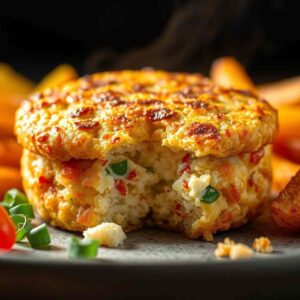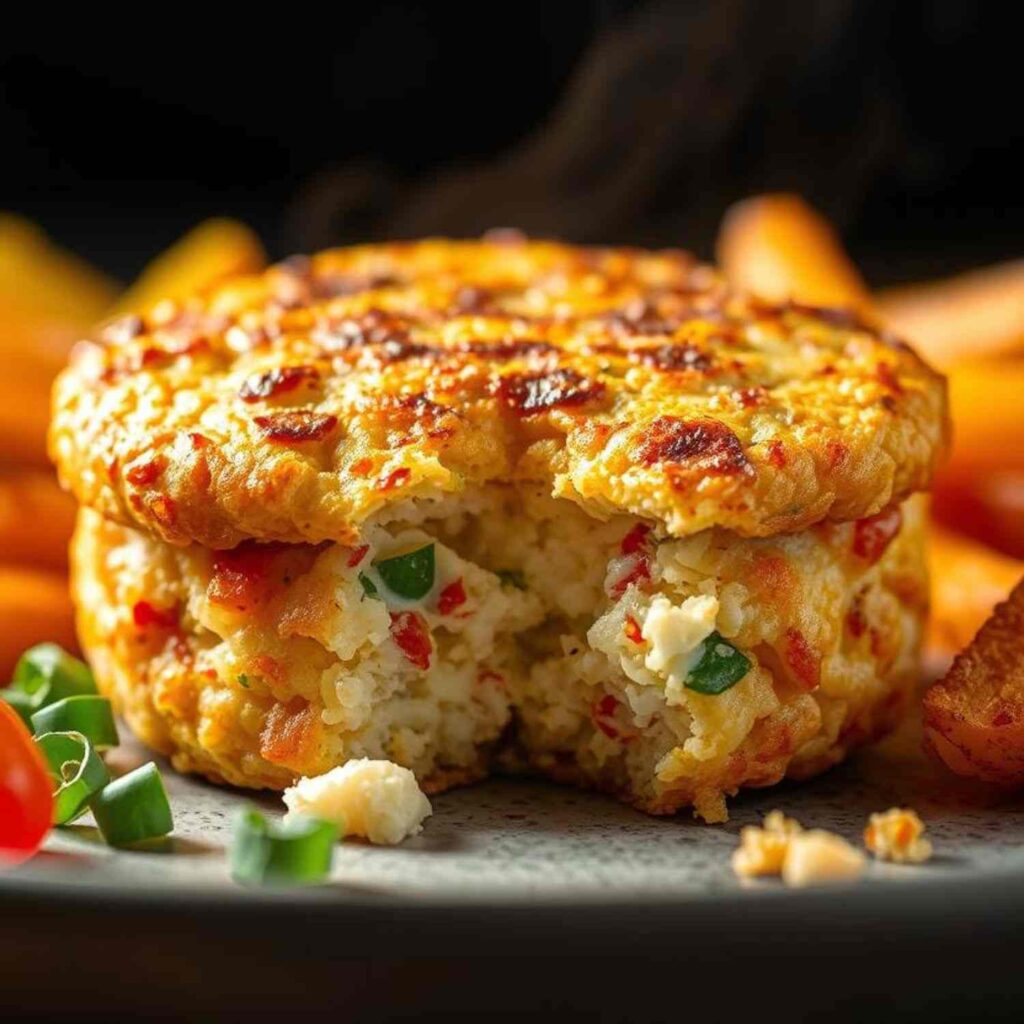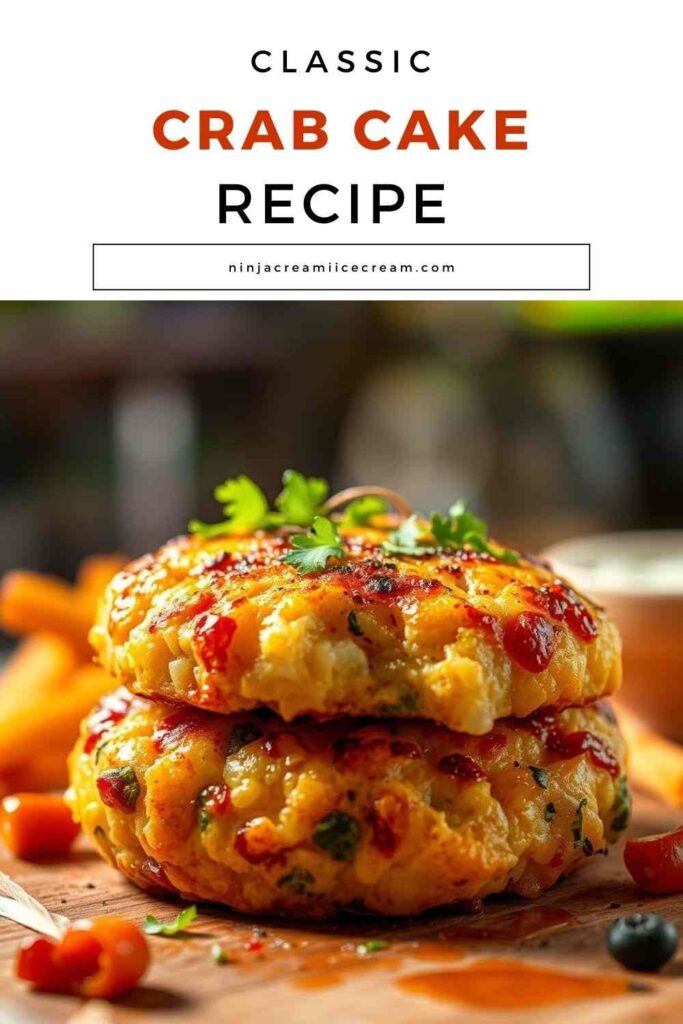Crab Cake are a beloved seafood dish that combines the delicate sweetness of crab meat with savory seasonings and crispy, golden-brown exteriors. Whether served as an appetizer or main course, this dish has become a staple in many coastal regions. There are countless variations, with regional influences shaping the flavor profiles and preparation styles. For instance, Maryland-style crab cakes are known for their rich, Old Bay seasoning and minimal filler, allowing the crab to shine. In contrast, Southern-style crab cakes often incorporate ingredients like bell peppers, garlic, and a bit of heat. What makes crab cakes truly special is the balance of fresh crab meat, breadcrumbs, egg, and seasonings such as mustard, Worcestershire sauce, and fresh herbs. These ingredients come together to create a dish that is both comforting and full of vibrant flavor.
Disclosure: This post may contain affiliate links. As an Amazon Associate, I earn from qualifying purchases. Read more.
Crab Cake Recipe
Ingredients for Crab Cakes
- Fresh Crab Meat
- The star of the dish, fresh crab meat brings a sweet, delicate flavor and tender texture to the crab cakes. You can use different types of crab meat, such as lump, backfin, or claw. Lump crab meat has large, succulent pieces, while backfin is slightly smaller and flakier. Claw meat is darker, with a richer taste. Always use high-quality, fresh crab meat for the best results, whether it’s picked fresh or canned.
- Breadcrumbs
- Breadcrumbs act as a binder for the crab cakes, helping hold the mixture together. Panko breadcrumbs are a popular choice for their light and crispy texture, creating a delicate crunch when cooked. Alternatively, you can use regular breadcrumbs or crushed crackers for a different texture.
- Egg
- The egg serves as a binding agent that helps keep the crab cakes intact while cooking. It also adds moisture to the mixture, ensuring the cakes don’t become too dry. One egg is typically sufficient for most recipes, but this can vary depending on the amount of crab meat and breadcrumbs used.
- Mayonnaise
- Mayonnaise adds richness and moisture to the crab cakes, contributing to a smooth texture. It also helps bind the ingredients together without overpowering the flavor of the crab. Some recipes use sour cream or Greek yogurt as a lighter alternative, but mayonnaise is the classic choice.
- Dijon Mustard
- Dijon mustard provides a subtle tang and slight spiciness that complements the sweetness of the crab. It also enhances the flavor profile, adding a bit of depth without being overwhelming. A tablespoon of Dijon mustard is typically used, but you can adjust it to taste.
- Old Bay Seasoning
- This iconic spice blend is a hallmark of Maryland-style crab cakes. It contains a mix of spices like paprika, celery salt, black pepper, cayenne, and mustard, which give the crab cakes their distinct flavor. Old Bay is optional in non-Maryland recipes, but it’s widely loved for its bold, aromatic flavor.
- Fresh Parsley
- Fresh parsley adds a pop of color and a hint of herbal freshness to the crab cakes. It also helps balance the richness of the other ingredients. A small handful of finely chopped parsley is commonly mixed in, though other fresh herbs like thyme or tarragon can be used for a different flavor profile.
- Worcestershire Sauce
- A small splash of Worcestershire sauce enhances the savory, umami flavor of the crab cakes. It adds depth and complexity without overshadowing the crab’s natural sweetness. A few dashes are usually sufficient.
- Lemon Zest
- Zesting a lemon adds a burst of citrusy freshness, complementing the sweet crab meat. The zest provides aromatic oils and a light acidity, brightening the overall flavor of the crab cakes. Fresh lemon juice is also commonly added for extra zing.
- Garlic
- Finely minced garlic provides a savory base to the crab cake mixture, elevating the other ingredients. It can be sautéed for a milder, sweeter flavor or added raw for a sharper kick.
- Bell Pepper (Optional)
- Some recipes include finely chopped bell peppers for added sweetness and crunch. This addition is especially common in Southern-style crab cakes, where the sweetness of the pepper balances the richness of the crab. Red, yellow, or green bell peppers work well.
- Salt and Pepper
- Basic seasonings like salt and black pepper are crucial to bring out the natural flavors of the crab and balance the other ingredients. Be sure to season to taste, as the crab meat and Old Bay already add a significant amount of flavor.
- Cooking Oil or Butter
- For pan-frying the crab cakes, you’ll need a bit of oil or butter to ensure a crispy, golden exterior. Vegetable oil or olive oil are often used, but some prefer butter for extra richness and flavor.
By combining these ingredients thoughtfully, you’ll create a perfectly balanced crab cake with tender crab meat, a crispy crust, and vibrant flavors. Adjust the seasoning to your liking, and feel free to experiment with additional herbs or spices!
Instructions for Making Crab Cakes
-
Prepare the Crab Meat
- Begin by preparing the crab meat. If you’re using fresh crab, gently pick through it to remove any bits of shell or cartilage. Be careful not to break up the large lumps of crab, as they provide the tender texture in the finished crab cakes. If using canned crab meat, drain it thoroughly and give it a light rinse to remove any briny liquid. Pat the crab meat dry with paper towels to ensure your crab cakes hold together during cooking.
-
Mix the Ingredients
- In a large mixing bowl, combine the crab meat, breadcrumbs, and egg. The breadcrumbs help bind the ingredients, while the egg provides moisture and helps hold everything together.
- Add in the mayonnaise and Dijon mustard. These ingredients provide creaminess and flavor, ensuring your crab cakes are moist and well-seasoned.
- Sprinkle in the Old Bay seasoning, fresh parsley, Worcestershire sauce, lemon zest, and minced garlic. These spices and herbs are what give crab cakes their distinctive flavor, so be sure to mix them in thoroughly.
- Season the mixture with salt and pepper to taste. Adjust the seasoning depending on your preference and the saltiness of the crab or Old Bay seasoning.
- Gently fold the mixture with a spatula or spoon. Be careful not to overmix or break up the crab lumps too much—keeping the crab in large chunks helps create a more decadent crab cake.
-
Shape the Crab Cakes
- Once all the ingredients are mixed, it’s time to form the crab cakes. Take a small handful of the crab mixture and shape it into a patty. Each patty should be about 1 to 1.5 inches thick and approximately 3-4 inches in diameter, though you can adjust the size based on your preference.
- If the mixture feels too loose or sticky, you can add a bit more breadcrumbs or a little flour to help with shaping. The mixture should hold together when pressed but not be overly dense.
- Place the formed crab cakes on a baking sheet or plate, spacing them out so they don’t touch. If you have time, refrigerate the crab cakes for at least 30 minutes to help them firm up. This step is important for keeping them intact while cooking.
-
Pan-Fry the Crab Cakes
- To cook the crab cakes, heat a couple of tablespoons of oil (vegetable oil or olive oil) or butter in a large skillet over medium-high heat. Once the oil is hot and shimmering (but not smoking), carefully place the crab cakes in the pan. Be sure not to overcrowd the pan to allow for even cooking.
- Cook the crab cakes for about 4-5 minutes per side. You want the cakes to develop a golden-brown crust on both sides while staying tender on the inside. Use a spatula to gently flip the crab cakes, taking care not to break them. If they seem delicate, you can use two spatulas to flip them more easily.
- Check for doneness by gently pressing on the cakes. They should be firm but springy to the touch. The internal temperature should reach 145°F (63°C) for safety.
-
Optional: Bake the Crab Cakes
- If you prefer a lighter cooking method, you can bake the crab cakes instead of pan-frying them. Preheat your oven to 375°F (190°C).
- Place the crab cakes on a parchment-lined baking sheet. Lightly brush or spray the tops with a little oil or melted butter to promote browning.
- Bake the crab cakes for 15-20 minutes, flipping halfway through, until they are golden brown and heated through.
-
Serving Suggestions
- Serve the crab cakes immediately after cooking for the best texture and flavor. They’re excellent on their own, but you can also serve them with a variety of sauces, such as tartar sauce, lemon aioli, or a remoulade sauce. A wedge of lemon can also be served for extra zest.
- For a complete meal, serve crab cakes with sides like coleslaw, roasted vegetables, or a fresh salad. For a special touch, you can place the crab cakes on a bun for a crab cake sandwich or wrap for a crab cake wrap.
-
Storage and Reheating
- If you have leftovers, allow the crab cakes to cool completely before storing them in an airtight container in the refrigerator. They will keep for up to 2 days.
- To reheat, gently warm them in a skillet over medium heat or in the oven at 350°F (175°C) for 10-15 minutes, flipping once to ensure even heating.
By following these detailed steps, you’ll be able to create crab cake that are perfectly crispy on the outside and tender on the inside, bursting with flavor from the fresh ingredients and seasonings.

Crab Cake Recipe
Equipment
- Mixing bowl To combine all the ingredients.
- Spatula or Spoon: For gently mixing the crab meat and other ingredients.
- Measuring Spoons and Cups: To measure seasonings, mayonnaise, mustard, and other ingredients.
- Skillet or Nonstick Pan: For pan-frying the crab cakes.
- Cooking Oil or Butter: For frying the crab cakes and achieving a crispy exterior.
- Plate or Baking Sheet: To place the crab cakes while shaping and refrigerating them.
- Fish Spatula or Regular Spatula: To flip the crab cakes gently while frying.
- Oven (optional): If you choose to bake the crab cakes instead of frying them.
- Paper Towels: For draining any excess oil after cooking.
Ingredients
- 1 lb lump crab meat (fresh or canned, drained and picked through)
- ½ cup breadcrumbs (preferably panko for a lighter, crispier texture)
- 1 large egg
- 1/4 cup mayonnaise
- 1 tablespoon Dijon mustard
- 1 tablespoon Worcestershire sauce
- 1 tsp Old Bay seasoning (or to taste)
- 1 tablespoon fresh parsley, finely chopped
- 1 tsp lemon zest
- 1 clove garlic, minced
- Salt and pepper, to taste
- 2 tablespoons vegetable oil (or butter) for frying
Instructions
- Prepare the Crab Mixture: In a large mixing bowl, combine the lump crab meat, breadcrumbs, egg, mayonnaise, Dijon mustard, Worcestershire sauce, Old Bay seasoning, parsley, lemon zest, garlic, salt, and pepper. Gently mix everything together, making sure not to break up the crab meat too much.
- Shape the Crab Cakes: Using your hands, form the mixture into small patties, about 2-3 inches in diameter. Place them on a plate or baking sheet.
- Chill the Crab Cakes: Refrigerate the shaped crab cakes for at least 30 minutes to help them hold together while cooking.
- Cook the Crab Cakes: Heat the vegetable oil (or butter) in a skillet over medium heat. Once hot, carefully place the crab cakes in the skillet and cook for 3-4 minutes on each side, or until golden brown and crispy.
- Serve: Remove the crab cakes from the skillet and place them on a plate lined with paper towels to drain excess oil. Serve with tartar sauce, aioli, or lemon wedges for added flavor. Enjoy!
Notes
- Use Fresh Crab Meat: For the best flavor and texture, always use fresh lump crab meat. If using canned crab, be sure to drain it thoroughly and pick through it to remove any shells.
- Don’t Overwork the Mixture: When mixing the ingredients, be gentle with the crab meat. Overworking it can result in dense crab cakes. The lumps should stay intact to preserve the crab's delicate texture.
- Chill the Crab Cakes: Chilling the crab cakes for at least 30 minutes before cooking is essential. This helps the cakes hold together and prevents them from falling apart while frying.
- Adjust Seasoning to Taste: Old Bay seasoning and Worcestershire sauce provide the classic flavor for crab cakes, but feel free to adjust the seasoning based on your preferences. You can add more mustard or lemon zest for a tangier taste or spice them up with a little hot sauce.
- Cooking Method: You can either pan-fry or bake the crab cakes. Pan-frying yields a crispier texture, while baking is a healthier alternative. If baking, brush the cakes with a little oil or butter for golden color.
- Ensure Even Cooking: Make sure the oil is heated properly before adding the crab cakes. If the oil is too hot, they will burn on the outside while remaining uncooked inside. Medium to medium-high heat is ideal.
- Test for Consistency: If the crab cake mixture feels too wet or loose, add more breadcrumbs gradually until it reaches a firmer consistency that holds together. If it's too dry, add a bit more mayonnaise.
- Serve Immediately: Crab cakes are best served right after cooking when they're crispy and warm. Pair them with dipping sauces like tartar sauce, remoulade, or lemon butter to enhance the flavor.
Tips for Perfect Crab Cake
- Use Fresh, High-Quality Crab Meat
- The quality of the crab meat is the key to great crab cakes. Fresh, lump crab meat yields the best flavor and texture. Avoid using imitation crab, as it lacks the sweetness and delicate texture of real crab. If fresh crab is not available, opt for well-drained, high-quality canned crab meat.
- Be Gentle with the Crab Meat
- When mixing the ingredients, avoid overworking or mashing the crab meat. The lumps should remain intact to preserve the tender, succulent texture. Gently fold the crab meat with the other ingredients and handle the mixture carefully while shaping the cakes.
- Chill the Mixture
- After shaping the crab cakes, chill them in the refrigerator for at least 30 minutes before cooking. Chilling helps the cakes firm up and hold together better during cooking. It also allows the flavors to meld, enhancing the overall taste.
- Don’t Overdo the Filler
- The key to a great crab cake is letting the crab shine. Avoid using too much filler, such as breadcrumbs or mayonnaise. The crab should be the star, and the filler should merely bind the ingredients together. If your mixture feels too wet, add breadcrumbs a little at a time until it holds together without becoming too dense.
- Use a Nonstick Skillet or Well-Oiled Pan
- A nonstick skillet or a well-oiled pan is crucial for getting a crisp, golden crust without the cakes sticking to the surface. Make sure the oil is hot before adding the crab cakes to the pan to avoid them becoming soggy.
- Test for Seasoning Before Cooking
- Before cooking all of your crab cakes, it’s a good idea to cook a small test patty to check the seasoning. Taste the test patty and adjust the salt, pepper, or other seasonings as needed.
- Fry at the Right Temperature
- Fry your crab cakes over medium to medium-high heat. If the heat is too high, the outside will burn before the inside is fully cooked. If the heat is too low, the cakes may become soggy or not crisp up properly. A golden-brown color on both sides is the perfect indicator.
- For Extra Crunch, Use Panko Breadcrumbs
- If you’re looking for a lighter, crispier texture, opt for panko breadcrumbs. They give the crab cakes a delicate crunch on the outside while keeping the inside tender. Regular breadcrumbs can be used if you prefer a denser texture.
- Use Butter for Extra Flavor
- If you’re frying the crab cakes, consider mixing a little butter with your oil for a richer flavor. Butter adds a deliciously savory taste and contributes to a golden, crisp exterior.
- Experiment with Add-ins
- While classic crab cakes often use minimal ingredients to highlight the crab, you can experiment with adding ingredients like finely diced bell peppers, onions, or a hint of hot sauce for extra flavor. Be careful not to overpower the crab with too many additional ingredients.
- Serve with a Fresh Sauce
- Crab cakes pair wonderfully with creamy dipping sauces like tartar sauce, remoulade, or garlic aioli. For a lighter touch, a squeeze of fresh lemon juice or a drizzle of lemon butter can enhance the flavors without overwhelming them.
- Keep the Crab Cakes Small and Even
- Aim for uniform-sized patties to ensure even cooking. Smaller crab cakes (about 3 inches in diameter) cook faster and maintain their shape more easily than larger ones.
- Baking Option for a Lighter Version
- If you’d prefer a healthier option, you can bake the crab cakes instead of frying them. Just preheat the oven to 375°F (190°C), place the crab cakes on a parchment-lined baking sheet, and bake for 15-20 minutes, flipping halfway through. Brush the tops with a little oil or butter to ensure a crispy texture.
By keeping these tips in mind, you’ll create perfectly crispy, flavorful crab cakes that highlight the natural sweetness of the crab, making them a crowd-pleaser every time!
Conclusion
Crab cake is a timeless, versatile seafood dish that brings out the delicate sweetness of crab while offering a satisfying texture and flavor profile. With their crispy golden crust and tender interior, they’re a perfect appetizer or main dish for any occasion, from casual family dinners to elegant dinner parties. The key to making the best crab cakes lies in using fresh, high-quality crab meat, carefully balanced seasonings, and minimal fillers to allow the crab to shine.
Whether you opt for the classic Maryland-style crab cakes with Old Bay seasoning or add your own twist with ingredients like bell peppers or fresh herbs, these cakes offer endless possibilities for customization. The easy-to-follow recipe allows for a variety of cooking methods, from pan-frying to baking, ensuring that you can tailor the dish to your preferences and dietary needs. Plus, with tips for perfecting the texture and flavor, you’re bound to impress anyone who tastes them.
Finally, crab cakes are not only delicious but also a fun dish to prepare. With a few simple ingredients and a little patience, you’ll be able to create restaurant-quality crab cakes in your own kitchen. Serve them with your favorite sauces and sides for a complete meal, and enjoy the delightful flavors of the sea in every bite.

Hi, I’m Katelyn Williams, the expert behind Ninjacreamiicecream.com. With a deep passion for creating delectable ice cream recipes, I’m here to share my love for all things ice cream. I earned my Bachelor’s degree from Louisiana State University, and since then, I’ve been dedicated to perfecting the art of ice cream making. From classic flavors to innovative creations, my goal is to inspire you to make delicious and creamy treats at home effortlessly. Join me for the best recipes, tips, and techniques to elevate your ice cream game and indulge in delightful frozen desserts!


